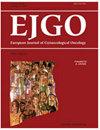Evaluation of colposcopy and LEEP results performed in gynecology and gynecological oncology surgery services
IF 0.5
4区 医学
Q4 OBSTETRICS & GYNECOLOGY
引用次数: 0
Abstract
The diagnostic performances of colposcopy and Loop Electrosurgical Excision Proce-dure (LEEP) results in gynecology and gynecological oncology surgical services were evaluated. Their differences regarding biopsy numbers were investigated. The other objective was to examine factors associated with recurrence and residual lesions after LEEP. This study included the cytology results of 1217 women undergone colposcopy at our hospital colposcopy unit between 2012 and 2017. The colposcopicsensitivity, specificity, positive predictive value and negative predictive value were calculated based on LEEP results. The qualitative data were compared by employing Chi-square and Fisher’s exact tests. χ2 predicted the relation between age and number of involved margins with recurrent disease. Moreover, it predicted the link between age, cytology and number of relevant margins with residual disease. There was no significant difference regarding the diagnostic performance of two groups when LEEP was determined as the gold standard against colposcopy. The diagnostic accuracy rate was 1.83 times higher when more than 2 biopsies were taken compared to 2 or fewer. A significant increase was observed in the residual rate among women having pre-LEEP high-risk human papillomavirus (HR-HPV) positive tests compared to those with HR-HPV negative tests (48.0% vs. 15.4%, p = 0.04). Women with ≥ High grade squamous intraepithelial lesion (HSIL)-positive margins in the first conization exhibited higher residual rates compared to those with High grade squamous intraepithelial lesion (LSIL)-positive margins (50.7% vs. 9.5%, p < 0.001). Patients ofpositive surgical margins, residual lesions and cervical intraepithelial neoplasia (CIN) with HPV 16 had higher probability of persistent HPV infection after conization. There was no significant difference pertaining to the diagnostic performance of two groups. HPV 16+ and the positive surgical margin were the predictive of recurrence.妇科和妇科肿瘤外科服务中阴道镜检查和LEEP结果的评估
评价阴道镜和环形电切术(LEEP)结果在妇科和妇科肿瘤外科服务中的诊断性能。研究了他们在活检次数方面的差异。另一个目的是检查与LEEP后复发和残留病变相关的因素。本研究纳入2012 - 2017年在我院阴道镜科室行阴道镜检查的1217例女性的细胞学结果。根据LEEP结果计算阴道镜敏感性、特异性、阳性预测值和阴性预测值。采用卡方检验和Fisher精确检验对定性资料进行比较。χ2预测年龄、受累切缘数与复发的关系。此外,它预测了年龄、细胞学和与残留疾病相关的边缘数量之间的联系。当LEEP被确定为对阴道镜检查的金标准时,两组的诊断性能无显著差异。2例以上活检的诊断准确率是2例以下活检的1.83倍。leep前高危人乳头瘤病毒(HR-HPV)检测阳性的妇女的残留率显著高于HR-HPV阴性的妇女(48.0%对15.4%,p = 0.04)。与高级别鳞状上皮内病变(LSIL)边缘阳性的女性相比,第一次穿刺时具有≥高级别鳞状上皮内病变(HSIL)阳性边缘的女性表现出更高的残留率(50.7% vs 9.5%, p <0.001)。手术切缘阳性、残留病变和宫颈上皮内瘤变(CIN)合并HPV 16的患者在锥形化后持续感染HPV的可能性更高。两组在诊断表现上无显著差异。HPV 16+和手术切缘阳性是复发的预测因素。
本文章由计算机程序翻译,如有差异,请以英文原文为准。
求助全文
约1分钟内获得全文
求助全文
来源期刊
自引率
25.00%
发文量
58
审稿时长
1 months
期刊介绍:
EJGO is dedicated to publishing editorial articles in the Distinguished Expert Series and original research papers, case reports, letters to the Editor, book reviews, and newsletters. The Journal was founded in 1980 the second gynaecologic oncology hyperspecialization Journal in the world. Its aim is the diffusion of scientific, clinical and practical progress, and knowledge in female neoplastic diseases in an interdisciplinary approach among gynaecologists, oncologists, radiotherapists, surgeons, chemotherapists, pathologists, epidemiologists, and so on.

 求助内容:
求助内容: 应助结果提醒方式:
应助结果提醒方式:


